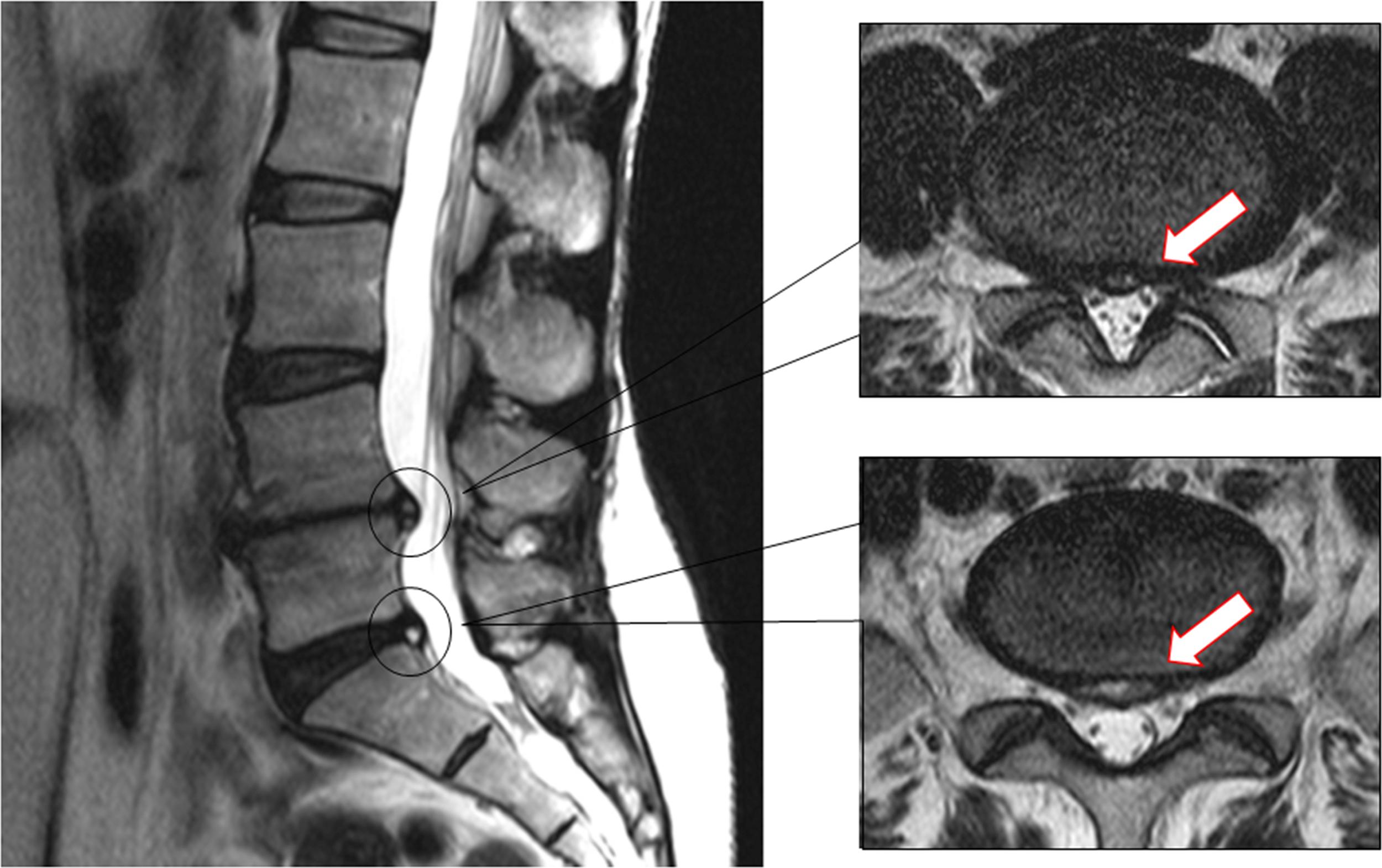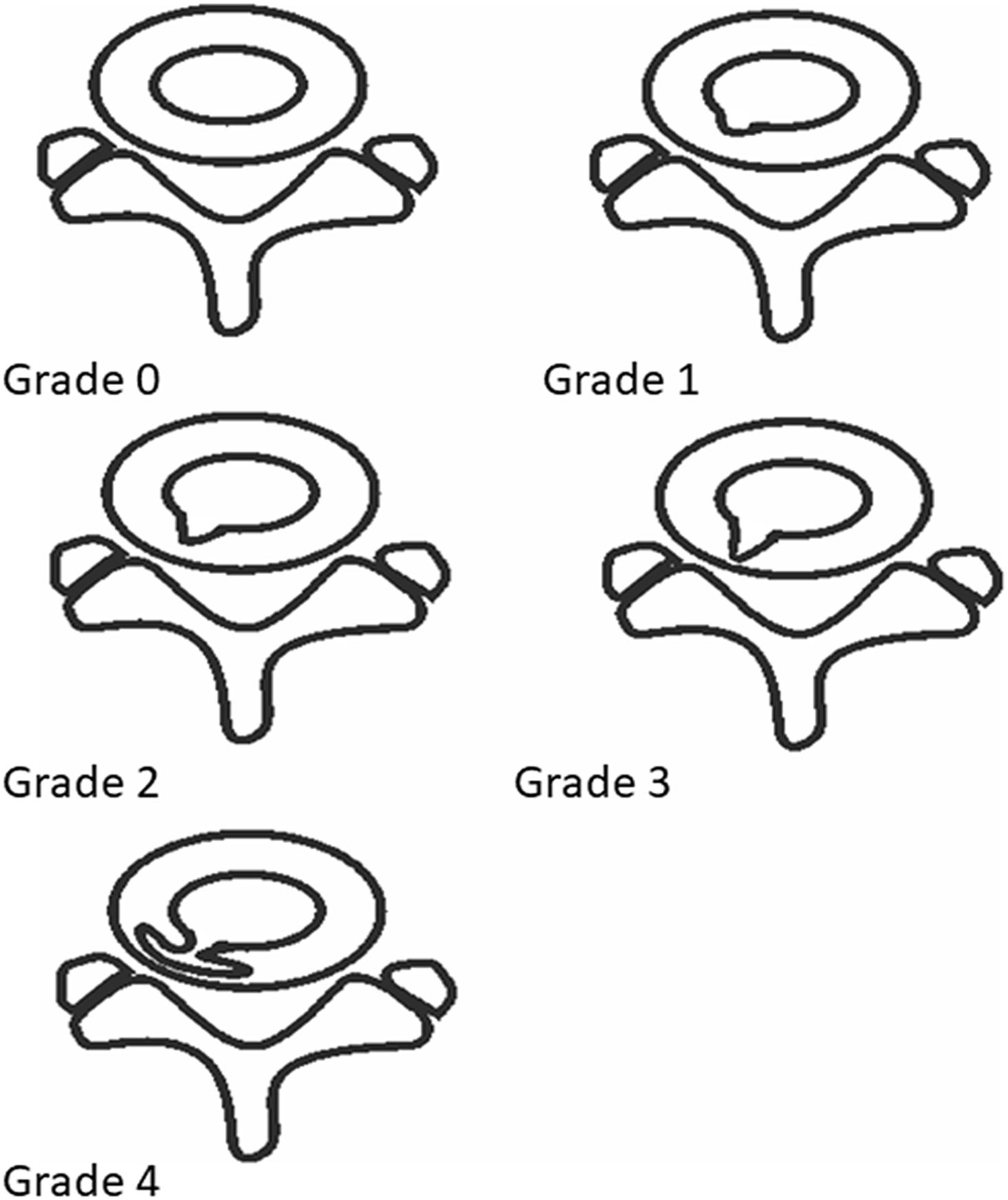Physical Address
304 North Cardinal St.
Dorchester Center, MA 02124
High-intensity zones (HIZs) represent a hyperintense signal on T2-weighted MRI in the region of the annulus fibrosus and can be used to represent annular tears.
HIZs have variable biomechanics, epidemiology, and risk factors and are associated with or without low back pain.
HIZs were considered as a specific pain and degenerative marker; however, this remains a matter of contention due to a lack of consensus.
HIZs have been reported to have varying presentations but the evidence is limited due to the lack of ethnicity standardization, inadequate sample size, lack of control population, low-level evidence such as cross-sectional study design, and heterogeneous study populations.
With advances in MRI techniques, a more detailed investigation of the underlying pathology and topography/monography of HIZ is underway.
Various HIZ classifications have been reported; however, a standardized scheme that can be precise and comprehensive is ideal, allowing its use for future analysis regarding phenotype association and clinical relevance research.
Low back pain (LBP) causes functional impairment, diminished quality of life, loss of working ability, potential psychological distress, and increased healthcare costs [ ]. Causes of LBP are many and variable, thus the actual culprit in around 90% of LBP patients cannot be distinguished [ , ]. Internal intervertebral disc (IVD) disruption of the lumbar spine can be a key pain generator leading to discogenic-related LBP [ ] (see Chapter 6 ).
To identify internal IVD disruptions, provocation discography was often used for the diagnosis and management of discogenic LBP. The procedure was first described by Lindbolm et al. [ ] and Hirsch et al. [ ] in 1948 and provides information on the morphological characteristics of the IVD and the provoked pain response [ , ]. However, discography is invasive and may cause complications including infection (epidural abscess, or discitis), neurological injury, and reaction to contrast medium, and may also promote IVD degeneration [ , ]. Due to risks as stated and the advancement in MRI technology to visualize the IVD (see Chapter 5 ), scientists recently have moved away from discography to assess the presence of any disc disruptions. Accordingly, lumbar MRI has become the gold standard for assessing the morphological architecture of the IVD and its relationship with discogenic LBP [ , ].
High-intensity zones (HIZs) are specific disc phenotypes that can be visualized by annular tears on MRI [ ]. Aprill and Bogduk [ ] first described HIZs to be located in the posterior annulus fibrosus (AF) ( Fig. 9.1 ) using T2-weighted (T2W) lumbar MRI in 1992. These findings were also correlated with findings on lumbar computerized tomography (CT) discography. Aprill et al. [ ] performed discography and CT discography for evaluation of HIZs as annular tears in 41 of 500 patients and found a significant correlation of discogram findings. According to the modified Dallas discogram scale ( Table 9.1 , Fig. 9.2 ) by Sachs et al. [ ], they demonstrated a sensitivity of 71%, specificity of 89%, and positive predictive value of 86% between HIZs on T2W MRI and a painful grade 4 IVD disruption (contrast medium spread an arc greater than 30 degrees through the AF) on CT discography.

| Grade 0 | Contrast medium entirely within a normal nucleus pulposus |
| Grade 1 | Contrast medium extending radially along a fissure involving the inner third of the annulus fibrosus |
| Grade 2 | Contrast medium extending to involve the middle third of the annulus fibrosus |
| Grade 3 | Contrast medium extending to involve the outer third of the annulus fibrosus forming an arc ≦30 degrees of the disc circumference |
| Grade 4 | Contrast medium extending into the outer third of the annulus fibrosus forming an arc >30 degrees of the disc circumference |

Aprill et al. [ ] also suggested HIZ to be a specific marker of discogenic LBP because of its correlation with provocation discography and patient concordant pain. Thus, this was a landmark report suggesting that detection of HIZs or annular tears, originally considered an elusive diagnosis, can be detected using noninvasive MRI instead of discography.
Several authors verified Aprill and Bogduk's findings of HIZs as annular tears in subsequent studies. Yu et al. [ ] and Osti et al. [ ] suggested this using T2W MRI findings of HIZs with annular tears in the AF in cadaver studies. They likewise proposed that the HIZ contained atomic material and granulation tissue caught inside the AF that represented the bright signal compared with the nucleus pulposus (NP) on T2W MRI. Yu et al. [ ] also developed a classification system of annular tears in cadavers while correlating with HIZs on T2W MRI. Three types of tears were described: (1) concentric, (2) radial, and (3) transverse ( Fig. 9.3 ). Concentric tears were crescentic or oval cavities associated with a rupture of the transverse fiber in the lamellae of the AF. Radial tears were described as fissures extending from the AF into the NP at the outer third of the AF in a plane oblique to the endplate (see Chapter 1, Chapter 10 ). Transverse tears were described as fluid-filled cavities in Sharpey's fibers near their attachment with the ring apophysis, which was discrete tears of the outer layers of the AF in a plane parallel to the endplate. Besides concentric tears, which were not visualized on T2W MRI, transverse and radial tears were depicted as fluid signals with higher signal intensity than the nucleus. However, it was considered generally difficult to define radial tears accurately on T2W MRI [ ].

The role of axial loading (see Chapter 2 ) of the IVD for the development of HIZs on T2W MRI is not yet defined. Saifuddin et al. [ ] demonstrated the development of HIZs by axial loading of the lumbar spine to 50% of the patients' bodyweight for 5 min with a compatible compression device under MRI screening compared to conventional MRI in one case report. Alyas et al. [ ] also reported that HIZs developed on extension and in an upright posture when compared with the neutral position on MRI, suggesting that the alignment (see Chapter 16 ) of the spine correlates highly with HIZ formation. However, Hanna et al. [ ] showed no difference in HIZ detection based on axial loading or conventional MRI in 41 patients. In addition, Canbay et al. [ ] investigated between 27 patients who underwent posterior fusion surgery and 26 conservative patients for HIZs and degenerative disc disease with LBP and noted that HIZs significantly decreased on 1-year follow-up MRI from preoperation MRI; however, HIZs in conservative patients did not change at 1-year MRI evaluation. As such, the authors concluded that the preserved lumbar motion would lead to the disappearance of HIZs. More detailed investigation regarding spine biomechanics is necessary to understand whether HIZ is related to the effects of posture and axial loading.
The overall prevalence of HIZs is variable between several reported studies especially with or without LBP ( Table 9.2 ) [ , ]. The prevalence of HIZs was reported to be from 14% to 63%; however, most of these studies had flaws including no comparative group when analyzing symptoms and heterogeneous populations [ , ]. Nevertheless, two studies with control groups showed that the prevalence of HIZs in asymptomatic subjects was lower than that of symptomatic subjects ( Table 9.2 ) [ , ]. Furthermore, in two population-based cohorts, the prevalence of HIZs in elderly Japanese was higher than 21-year-old subjects of a birth cohort ( Table 9.2 ) [ , ]. Despite these findings, the conclusions from these papers have limited significance as the subjects were of different ethnicity and average age.
| Author | Year | Sample size | Age (yr) | Radiologic methods | Prevalence | The highest prevalence at disc level | Association with LBP |
|---|---|---|---|---|---|---|---|
| In symptomatic subjects study | |||||||
| April et al. [ ] | 1992 | 500 (male:female = 5:2) | Between 20 and 60 yr | 0.6T MRI and provocate discography, CT discography | 28.6% | L4/5 and L5/S | HIZ is painful internal disc disruption |
| Schellhas et al. [ ] | 1996 | 63 | 20–56 yr | 1.5T MRI and discography | 63% | L4/5 and L5/S | HIZ is a reliable marker of LBP |
| Rankine et al. [ ] | 1999 | 156 (male:female = 91:65) | 16–84 yr, mean age 43 yr | 1.5T MRI and discography | 45.5% | Significant correlation between concordant pain response and HIZ | |
| Lam et al. [ ] | 2000 | 73 | Mean 42 yr | 1.5T MRI and discography | 50% | L4/5 48%, L5/S 35% | Significant correlation between concordant pain response and HIZ |
| Peng et al. [ ] | 2006 | 52 (male:female = 39:13) | 18–62 yr | 1.5T MRI and discography | 33% | All 17 discs with HIZ showed painful reproduction | |
| Park et al. [ ] | 2007 | 737 | 10–60 yr | MRI | 15.9% | L4/5 9.6%, L5/S 9.1% | Significant correlation between concordant pain response and HIZ |
| In asymptomatic subjects study | |||||||
| Jensen et al. [ ] | 1994 | 100 asymptomatic patients | 20–80 yr | 1.5T MRI | 14% | No significant correlation between LBP and HIZ | |
| Both a symptomatic and control study | |||||||
| Buirski et al. [ ] | 1993 | 178 (115 symptomatic and 63 asymptomatic patients) | 15–52 yr | MRI and discography | 31% of asymptomatic subjects and 47% of symptomatic subjects | No significant correlation between concordant pain response and HIZ | |
| Carragee et al. [ ] | 2000 | 96 (42 symptomatic and 54 asymptomatic patients) | 22–57 yr | 1.5T MRI and discography | 25 subjects had HIZ of the 42 symptomatic subjects. 13 subjects had HIZ of the 54 asymptomatic subjects. | Pain response on discography was equal in symptomatic and asymptomatic individuals. | |
| Takatalo et al. [ ] | 2012 | 554 | 21 yr | 1.5T MRI | 3.20% | No significant correlation between LBP and HIZ | |
| Teraguchi et al. [ ] | 2016 | 814 | Mean age 63.3 yr | 1.5T MRI | 38.0% | No examination | |
| Teraguchi et al. | 2020 | 1214 | Mean age 48.1 yr | 1.5T MRI | 59.1% | Multilevel homogeneous or heterogeneous HIZs were significantly associated with prolonged, severe LBP | |
Become a Clinical Tree membership for Full access and enjoy Unlimited articles
If you are a member. Log in here